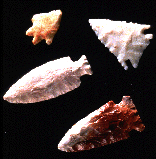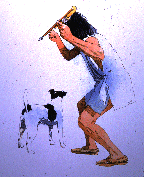Archaic Technology
New Technologies
 Tools and ornaments were made from stone, bone, shell, and wood. Archaic people wore simple clothing made from animal skins or plant fibers. They hunted with stone-tipped spears, fished with bone hooks, traps, and nets. Shells, gourds baskets, and animal skin bags served as containers for food and water. Cooking was done over open fires and in shallow heated pits.
Tools and ornaments were made from stone, bone, shell, and wood. Archaic people wore simple clothing made from animal skins or plant fibers. They hunted with stone-tipped spears, fished with bone hooks, traps, and nets. Shells, gourds baskets, and animal skin bags served as containers for food and water. Cooking was done over open fires and in shallow heated pits.
In spite of its simplicity, however, Archaic technological innovations clearly signal new ways of living in new environments. Ground stone tools for cutting trees appear. More intensive use of seasonally available plant resources by Archaic peoples is clearly demonstrated in a technological innovation, the grinding stone. Grinding stones made it possible to obtain nutritious foods from otherwise difficult to eat or digest nuts and seeds. By 7000 years ago post-hole patterns on many sites demonstrate the use of permanent pole-frame houses. Between 7000 and 3000 years ago, larger subterranean pits for the storage of food appeared. The small size and frequency of these pits indicate, however, that foods were not stored in large quantities for long periods of time.
 New hunting technologies also appear throughout the Archaic period. The spear thrower, or atlatl, with its hooked tip had the effect of lengthening the throwing arm, allowing hunters to throw their spears harder and more accurately at greater distances. It is possible that this innovation may be an adaptation to the replacement of large Pleistocene herd mammals like mastodon and mammoth with smaller, more solitary forest-dwelling species. Banner stones or weights allow the thrower to adjust the balance of the atlatl and thus the flight and impact force of the spear.
Text about points
New hunting technologies also appear throughout the Archaic period. The spear thrower, or atlatl, with its hooked tip had the effect of lengthening the throwing arm, allowing hunters to throw their spears harder and more accurately at greater distances. It is possible that this innovation may be an adaptation to the replacement of large Pleistocene herd mammals like mastodon and mammoth with smaller, more solitary forest-dwelling species. Banner stones or weights allow the thrower to adjust the balance of the atlatl and thus the flight and impact force of the spear.
Text about points
 New hunting technologies also appear throughout the Archaic period. The spear thrower, or atlatl, with its hooked tip had the effect of lengthening the throwing arm, allowing hunters to throw their spears harder and more accurately at greater distances. It is possible that this innovation may be an adaptation to the replacement of large Pleistocene herd mammals like mastodon and mammoth with smaller, more solitary forest-dwelling species. Banner stones or weights allow the thrower to adjust the balance of the atlatl and thus the flight and impact force of the spear.
Text about points
New hunting technologies also appear throughout the Archaic period. The spear thrower, or atlatl, with its hooked tip had the effect of lengthening the throwing arm, allowing hunters to throw their spears harder and more accurately at greater distances. It is possible that this innovation may be an adaptation to the replacement of large Pleistocene herd mammals like mastodon and mammoth with smaller, more solitary forest-dwelling species. Banner stones or weights allow the thrower to adjust the balance of the atlatl and thus the flight and impact force of the spear.
Text about points
 Tools and ornaments were made from stone, bone, shell, and wood. Archaic people wore simple clothing made from animal skins or plant fibers. They hunted with stone-tipped spears, fished with bone hooks, traps, and nets. Shells, gourds baskets, and animal skin bags served as containers for food and water. Cooking was done over open fires and in shallow heated pits.
Tools and ornaments were made from stone, bone, shell, and wood. Archaic people wore simple clothing made from animal skins or plant fibers. They hunted with stone-tipped spears, fished with bone hooks, traps, and nets. Shells, gourds baskets, and animal skin bags served as containers for food and water. Cooking was done over open fires and in shallow heated pits.